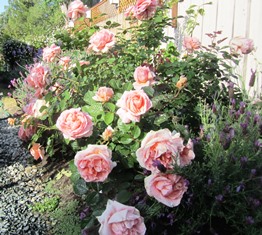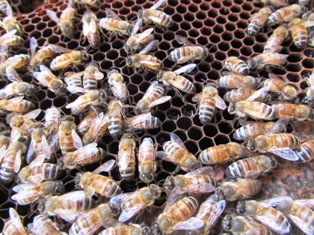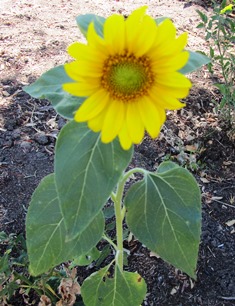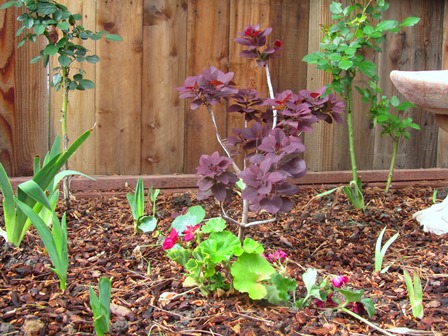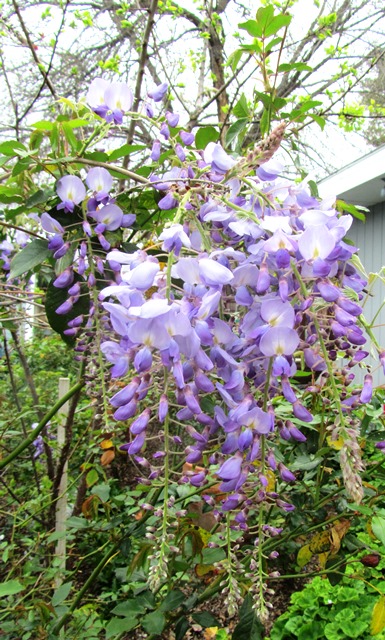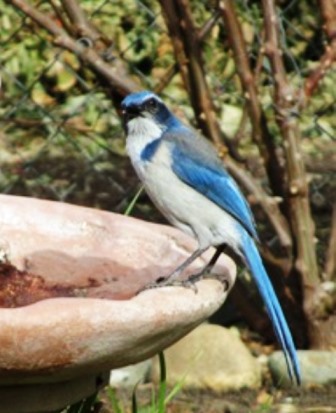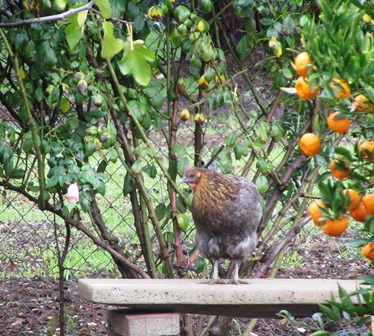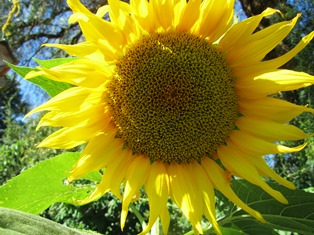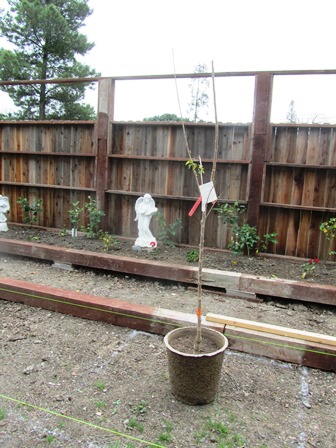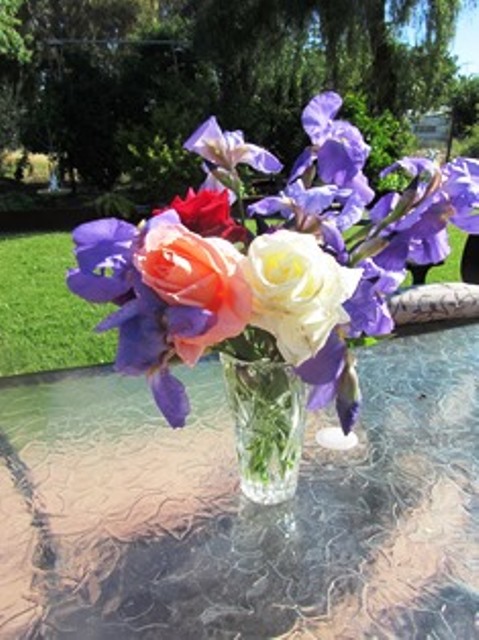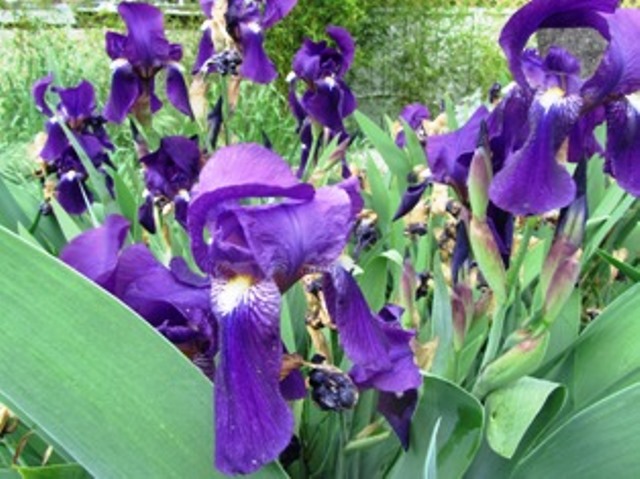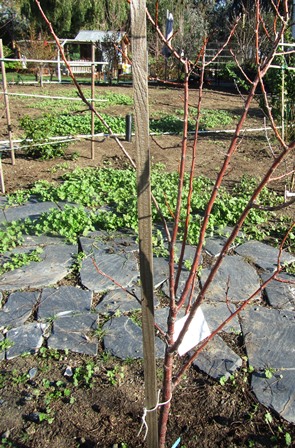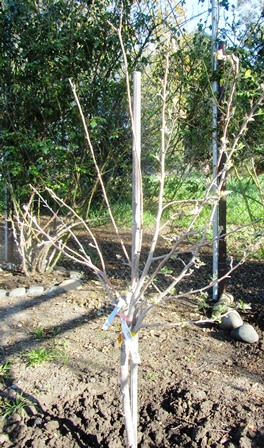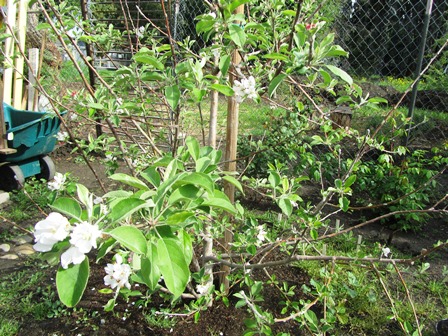Archive for the 'Plants and Trees' Category
Garlic–A Staple of Any Kitchen Garden
No proper kitchen garden would be without a section for onions (whether spring green onions, chives, or bulb onions) or garlic. Both kitchen staples are easy to grow. In several raised beds measuring four feet by six feet, I’ve planted garlic amidst a few jalapeno pepper plants. Garlic benefits other plants in the garden as well.
BEST TIME FOR PLANTING
In spring, after all danger of frost has passed, plant garlic cloves. Or, plant in late fall when you might be planting other types of bulbs. Some European gardeners swear that garlic must be planted on the shortest day of the year, the winter solstice.
I planted my garlic in late February/early March, long before my tomatoes, eggplant, pumpkin, and squash (the heat lovers) went in. The green garlic tops shoot out of the soil quickly and grow fast.
HOW TO PLANT GARLIC
Plant each clove from a bulb upright in soil roughly one-inch deep. Space the cloves four-inches apart. The growing site must receive full sun. Give the garlic a good watering each week. Garlic is a beneficial companion plant in the garden because of allicin (a property that acts as a fungicide and pesticide), especially when planted near lettuce and cabbage where it will deter aphids.
HOW TO HARVEST AND STORE GARLIC
When the tall green shoots of the garlic become dry and turn brown, it’s time to harvest the garlic bulbs. After you’ve pulled the bulbs out, shake off the dirt (never wash) and then hang the bulbs in a dark, dry place. Then when the bulbs are completely dry, you can braid the paper-dry tops to hang the garlic in the kitchen for easy access.
Propagating Plants from Rose Cuttings
Roses are among the most romantic flowers in a garden. I grow dozens of cultivars of rose bushes–climbers, hybrid teas, floribundas, and polyanthas. When I have an extra few dollars, I might spend it on a rose bush, but when money is tight, I simply start a new bush from one of my favorites that I’m currently growing.
My husband and I love the climbers. We have tall fences (over six feet) around our property on all sides. Covering an entire fence is easy when you use a vigorous, virtually pest-free climber. Two roses that quickly adapt and grow to fantastic heights are Sally Holmes and Cecile Brunner.
Climbing roses need strong support, since some canes can reach forty feet or more as they scramble over a roof or stone wall, trellis, fence, or arbor.
Last year, my husband created a rose arbor on wires strung from the fence along the north side of our house to the roof line. He planted the Cecile Brunner rose as his climber of choice. Its sage green leaves make a lovely foil for the tiny pink roses that permeate the air with a spicy-sweet scent throughout the spring. Cutting and feeding will render another bloom in summer.
My garden has plenty of places where I could tuck in a new rose bush, and I’ve bought many over the years. I have some favorites that I’d like to start in other areas. They include A Shropshire Lad, Handel, Lady Banks (a thornless yellow rose), and Iceberg.
This is the perfect time to propagate roses from cuttings in the Bay Area since the rose bushes in many yards are beginning to awaken. Roses require water, something no longer plentiful in California. Thanks to a severe four-year drought, we now have mandatory water restrictions. That means we gardeners must consider how we can recycle water, use gray water, collect water, and otherwise find ways to reduce water usage.
To propagate a rose from your favorite bush, take a six-inch cutting from a healthy cane. Make the bottom cut a sharp angle cut, not straight across. Do not crush the stem. Remove the leaves.
Dip the angle cut into a jar of root hormone powder. This powder enables the cane to root more easily in the ground or pot.
Insert the prepared cutting in the soil. Water as needed when the soil is dry. The cutting will need one to two months to root and then, it will begin to leaf out.
Some people like to put a quart jar over their cutting to create a mini-green house climate. In mild climates like the Bay Area, this isn’t necessary. The best time to propagate cuttings from your favorite roses is in the spring and never in extremes of cold or heat.
Creating romance in the garden could start with a table and chairs, floral-motif linens, and a service of tea. But even before those accoutrements to romance are added, why not fill the space with roses? It’s so easy.
An Heirloom Selection of Old Varieties of Flowers
Mid-March to early April on the farmette brings the celebration of birthdays and the promise of new selections of flowers for our spring gardens. This year, our new plants are old varieties.
A fellow-gardener friend gave me a selection of antique flowers for pollinators that included Bee Balm, Sweet Alyssum, Prickly Poppy, Sunflowers, and Kiss-Me-Over-The-Garden-Gate. These will go in various flower beds around our property.
Pollinators include many species of bees. We want them in our gardens to pollinate our fruits, vegetables, berries, and nut crops. Planting open-pollinated flowers enable pollinators to forage for pollen and nectar (their sources of food). When we provide rich food sources for pollinators, our food crops will benefit.
At a time when bee populations are declining worldwide, gardeners everywhere can help the besieged bees by planting diverse, open-pollinated varieties of pollen- and nectar-rich flowers. The following flower selection are considered old garden mainstays.
Bee Balm–“Bergamo” Monarda hybrida
This perennial likes sun to light shade and soil that is moist, and well-drained. The plant will reach two feet tall and will bloom summer to fall. It attracts both hummingbirds and bees.
Sweet Alyssum–“Benthalmii” Lobularia maritima
Alyssum is an annual that likes full sun but part shade in the hottest areas of hte garden. Soil preferences is rich, moist, and well-drained. It reaches a height of ten inches and small white blooms form summer to fall. It will flower repeatedly if it is clipped back after flowering.
Prickly Poppy–“Busy Bee” Argemone platyceras
A sun lover like all poppies, this one is an annual that loves poor, dry, gravelly soil. It will grow to three feet and bloom throughout the summer into fall. It does have prickly spines, so care must be taken to avoid contact with the spines.
Sunflowers–“Pan,” Helianthus debilis, subspecies: cucumerifolius
Another sun lover, this annual thrives in rich, well-drained soil. Plants will reach three feet in height and bloom summer through the fall. These sunflowers make excellent cut flowers.
Kiss-Me-Over-The-Garden-Gate–” Polylgonum orientale
This annual will go at the back of the garden since it reaches a height of six to seven feet. It likes well-drained, moist, rich soil that is located in full sun. The plants bloom summer throughout the fall and self-sows.
Trying New Plants in the Garden
While some people might like to stick to tried-and-true types of plants in their gardens, I’ve always enjoyed experimenting with botanical specimens that are new to me. Recently, I purchased two smoke trees–plants I’ve never before cultivated.
The smoke tree’s value is in its satiny leaves that are blue-green or deep purple. In addition to the gorgeous round leaves (so very Feng Shui), the plant has very tiny flowers that appear in summer along feathery inflorescences that, in the purple variety, are nearly the same color as the leaves. The blue-green smoke trees have tiny yellow flowers.
The great thing about this plant is is adaptability to poor soil. That includes even rocky soil. The downside is that the plant requires pruning to achieve a denser tree since it tends to be open branching. The blooms appear when the wood of the tree is three years old. My trees are small, however, one already has sprouted the feathery inflorescences.
The smoke tree adds drama to shrub borders and mass plantings because of its dark color. I’ve placed it amid fuschia geraniums, purple and lavender irises, citrus trees, and Abbaye de Cluny roses. I also planted climbing Sally Holmes, which will cover the front fence with 3 1/2-inch creamy white blooms and dense green foliage.
The smoke tree tends to grow eighteen to twenty feet and its lovely purple color does not fade, even in intense summer heat. I look forward to many years of enjoyment, watching this tree take center stage in the long rectangular beds at the front of our farmette.
Flowers, Nest-Building, and Bee Swarms . . . Spring Has Arrived
The wisteria hangs in long purple bracts, its color finding resonance in the grape hyacinth blooms and the lavender buds. Delicate blossoms of pink and white create canopies of color for the fruit trees, and birdsong fills the air. Spring brings its gifts.
As the blue jay creates a screeching racket to the mockingbird’s ready song, the white-crowned sparrows have taken up residence in a row of birdhouses we’ve placed high on the back fence.The entrances of the sparrow houses are too small for the jay to access; a good thing since jays have earned a reputation as nest robbers.
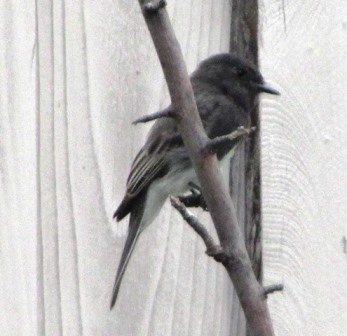
Crew Cut, our resident black phoebe, nests under an eve of the old chicken house; the male teaches its young to catch insects on the wing
Yesterday, I spotted the black phoebe pulling a piece of coir from a wall planter for its nest. These peaceful birds make a sound of tsip or fi-bee, fi-bee and can rise to roughly 50 feet to sing to a female.They range from California to central Texas, and even venture all the way to Argentina.
In the tallest eucalyptus on the acre that stands vacant behind our property, a pair of hawks are also nest-building. My farmette lies in their flight path. Not a good thing to see–hawks swooping down over my chickens and then rising to their lofty nest.
I threw some wildflower seed in beds over the weekend and then, after spotting my neighbor’s errant hen who flew to our yard, I began to regret my action. What can I do now but hope that she’ll not devour the seeds with her constant hunting and pecking?
Last night, I could have sworn I heard the pitter-patter of raindrops against the stone patio floor. With a steaming mug of coffee in hand at four o’clock this morning, I ventured outside and sure enough . . . it was still sprinkling. Hooray! It’s our first spring shower!
So, with all the nest-building and Mother Nature dropping a shower upon us, I know the wildflowers are blooming, too. That means the honeybee season is upon us. My neighbor has already had a bee swarm. I’m not ready, but I can’t stop Mother Nature from beginning a new cycle of seasons just because I don’t yet have my new honey frames assembled. That’s not how it works. Ready or not, spring has arrived.
Giant Sunflowers Provide Food and Fun for Everyone
Giant sunflowers need space to grow to full size; they can reach six or more feet tall. Bees love them for their pollen. Kids love them when the foliage of the plants create a secret fort or a fairy circle. Humans, birds, and squirrels love them for their seeds.
For best results, plant giant sunflowers at the back of a garden. They need good soil and full sun. Plant when the danger of frost has past. A rule of thumb to follow is to plant them about one inch deep and six inches apart. While the seeds are germinating, keep the soil moist.
Later on, when the plants stand about three inches tall, you can begin to thin them. Leave about one foot between each plant. This can enable a strong root system for form. The stalks will become sturdy and measure about three to four inches in circumference when fully grown.
First come the gorgeous petals in green to yellow and then bright yellow. As the bees pollinate the florets and they drop, the seeds will mature. Seeds are either gray or brown in color.
I always cut the heads when the seeds are plump, firm, and begin to drop. I let the heads dry well in the sun for days before I remove the seeds. Fully dry seeds can be stored in containers for human consumption or to be fed to the squirrels and birds.
* * *
If you enjoy reading about farmette topics (including gardening, beekeeping, and delicious recipes), check out my cozy mysteries A BEELINE TO MURDER and also THE MURDER OF A QUEEN BEE in the Henny Penny Farmette series (from Kensington Publishing).
These novels are available through online retailers such as Amazon, Barnes & Noble, Kobo Books, and Walmart as well as from traditional bookstores everywhere.
See, http://tinyurl.com/hxy3s8q
Now available in mass market paperback, this debut novel launched the Henny Penny Farmette series of mysteries and sold out its first press run.
See, http://tinyurl.com/h4kou4g
The second cozy mystery in the Henny Penny Farmette series, available Sept. 27, 2016
The Start of Something Wonderful . . . Spring!
I jumped at the chance to visit my favorite nursery this past weekend after my husband suggested a drive to Livermore, California. Alden Lane Nursery occupies a beautiful setting amid ancient oaks and there is even a honeybee hive on the premises. Wisteria blooms in perfusion there this time of year.
We came away with some pepper plants, two smoke trees, and four cherry trees, including Bing and Black Tartarian, its pollinator.
We are going to plant the cherry trees at the front of our property and the smoke trees will go in that area as well. We’ve done very little landscaping on the front of our land, preferring to get the trees and gardens in at the back near our hives and chicken run.
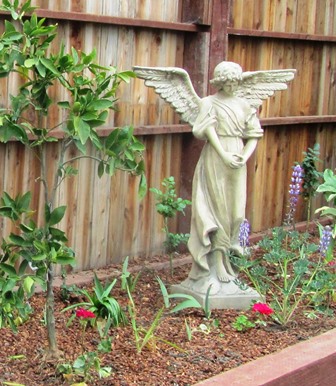
The beds that run the length of the fencing at the front of the farmette feature statuary, citrus, and bedding plants
Everywhere you look on the farmette, there are projects to be done. We chip away at them when we can. My husband works days and I write my novels, so the work will undoubtedly be never-ending. But that’s okay. We aren’t in a hurry and it’s easier to just live by the cycles and seasons of nature.
When I think of how the peaches and apricots are forming and the bees are almost ready to swarm, I know spring is here. And it’s my favorite season, so I’ll go outside, ignore the projects, have a cup of tea, and enjoy the start of something wonderful!
What Could Be Easier than Growing Irises in Raised Beds?
When we first moved to the Bay Area from Miami, the heirs to the property behind ours gave us some bearded irises that had been planted in the 1950s by their parents. I recall the beauty of irises on my grandmother’s farm in Missouri. She called them flags.
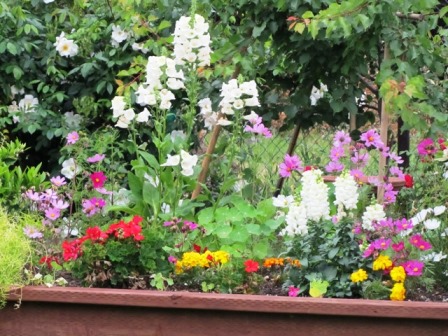
For a lovely raised flower bed, plant other bloomers like cosmos, geraniums, pansies, nasturtiums, and marigolds with iris cultivars
Mostly colored in deep purples and blues, white, and pinkish-beige, the bearded irises have added an aesthetic appeal to our farmette that was mostly just a big field with a tiny house in the middle. We’ve planted them in the ground, along fences, and in raised boxes.
Easy to grow and maintain, the irises have become one of our favorite flowers. We’ve kept them going in our garden and they’ve rewarded us with many new rhizomes.
As we’ve continued to restore the farmette, we’ve built many four by six feet boxes for raised beds. The materials cost roughly $125 per box. We like them because we can easily control the soil (building it up with compost, manure, and other amendments), drainage, tilling, and weeds. Recently we decided to make irises the mainstay of a raised bed border.
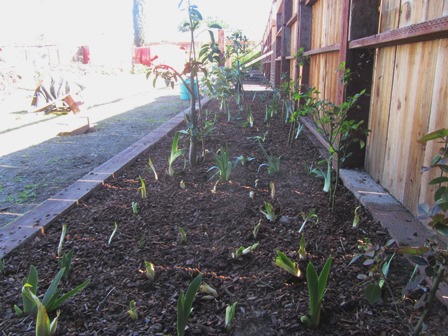
We’ve interplanted citrus and bearded irises in this raised bed spanning the length of the front fence
Over the weekend, we built a long raised bed that extends the entire length of the fencing on the southwestern side of our property. In it, we planted lots of citrus trees, climbing roses, and irises. If you are thinking of doing something comparable, have fun choosing from among the hundreds of cultivars of bearded and Siberian irises.
Plant them about three inches deep and a few inches apart in well drained, fertile soil. Irises need shade from the hottest sun and enjoy a deep drink of water, especially during blooming. I enjoy the ease of growing them in raised beds and love, love, love the magnificent color atop tall stalks when they bloom.
Early Bird Tips for Bare-root Fruit Trees
Gardeners understand that appearances can be deceiving. For example, during bare-root season (starting now in the Bay Area), twiggy fruit trees with no leaves are becoming plentiful offerings in local nurseries.
Bare-root trees are so-called because their roots are bare and packed in moist sawdust inside a burlap wrap. This makes it easy for the gardener to estimate the size of the planting hole (make the hole twice as deep and wide as the tree’s roots).
Plant two or three bare-root trees (select those that will pollinate each other for best results) in a single hole if space is a consideration. This is called high-density planting.
Consider a multi-grafted tree if you desire several types of fruit. Because the grafted trees use a basic tree and graft on scions of other varieties (often the same type of fruit such as apples), some branches will blossom and leaf out before others.
Another space saver in the garden is the espaliered tree. Choose a sunny place against a trellis, fence, or wall to train your tree, using wires for support. You will be directing its limbs to grow in a horizontal pattern.
All plants need water and food. During the winter, you may need very little water but in spring and summer check the soil often and when it’s dry down two inches, be sure and water your plant.
Fertilize your trees three times each year: after blossoming, after fruiting, and in the fall.
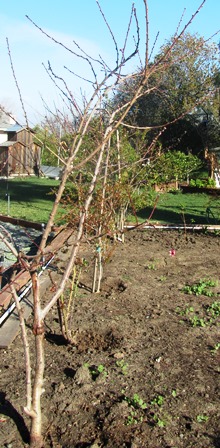
Planted in a row along a gravel path is a peach, a tea rose bush, an apricot, and a pomegranate tree
Prune your fruit trees in early winter, when the tree is dormant. With these early bird tips, your bare-root trees will get off to a great start.
Tis the time for Cool Season Planting
If you love the cool season plants like lettuce, spinach, kale, onions, leeks, sugar snap peas, and artichokes, Valentine’s Day weekend is the time to start planting cool season crops in the Bay Area and other warmer climates.
I put in onions throughout the cool season and am rewarded with burlap bags of red onions, yellow, white, and the walla walla variety for kitchen soups and other culinary creations during the first months of the year.
My husband is building more growing boxes (4 x 4 x 3) in which we shovel amended soil, some planting mix, bone meal, blood meal, compost, and chicken manure. The soil will grow almost anything.
This weekend, we’re moving a couple of citrus trees and three rose bushes. I’ll feed and water and watch for the new shoots to show within a week or two if the weather stays warm. So, you see, Valentine’s Day isn’t just for lovers but also people who love to garden.
 Facebook
Facebook Goodreads
Goodreads LinkedIn
LinkedIn Meera Lester
Meera Lester Twitter
Twitter




